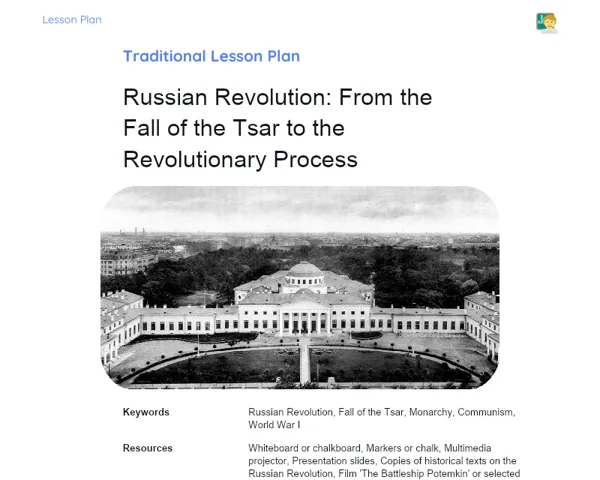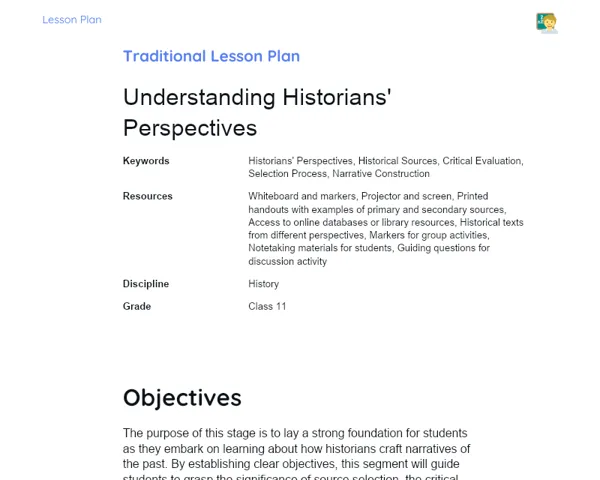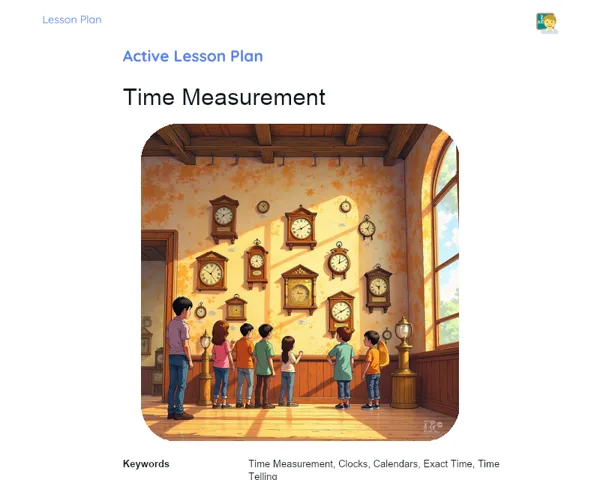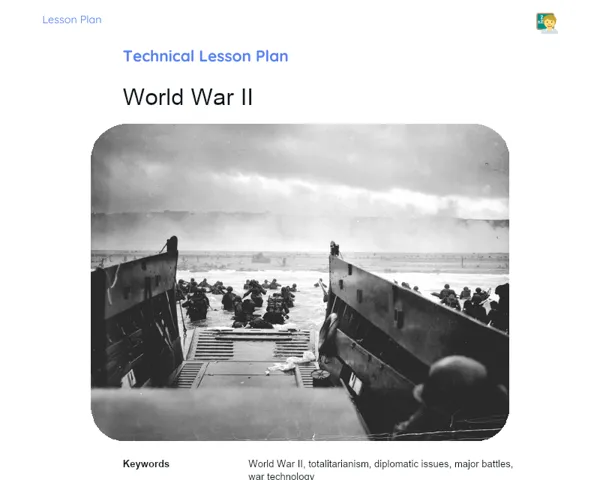Lesson Plan | Active Methodology | Cold War: Peaceful Coexistence, Conflicts and Social Movements: Review
| Keywords | Cold War, Peaceful Coexistence, Conflicts, Social Movements, Proxy Wars, Ideologies, Power Dynamics, Negotiation, Simulation, Strategy Game, Critical Analysis, Contemporary History, Interactive Education, Diplomacy, United States, Soviet Union, Historical Twists |
| Necessary Materials | Briefings with sensitive information, Film clips, Strategy game board, Random event cards, Projector, Computer, Internet connection, Writing materials, Note papers, Space for summit simulation |
Premises: This Active Lesson Plan assumes: a 100-minute class duration, prior student study both with the Book and the beginning of Project development, and that only one activity (among the three suggested) will be chosen to be carried out during the class, as each activity is designed to take up a large part of the available time.
Objective
Duration: (5 - 10 minutes)
This Objectives section lays the groundwork for students' learning, providing clear expectations regarding understanding and analysis, ensuring both teacher and students are aligned for a fruitful lesson.
Objective Utama:
1. Grasp the concept of the Cold War and pinpoint its key features, like the rivalry between the United States and the Soviet Union, the involvement in proxy wars, and the prevailing tension without direct confrontation.
2. Examine the ramifications of capitalist and communist ideologies on the geopolitics of that time, recognizing their impacts across various parts of the world, such as Europe, Asia, and Latin America.
Objective Tambahan:
- Cultivate skills for critical historical analysis, enabling students to scrutinize primary and secondary sources to form their insights into the Cold War era.
Introduction
Duration: (15 - 20 minutes)
The Introduction phase aims to engage students actively, prompting them to draw on their prior knowledge. The problem-based scenarios encourage critical thinking about the repercussions of political actions during the Cold War, while the contextualization emphasizes the relevance of studying this historical phase. This groundwork sets the stage for a more in-depth and practical discussion during class activities.
Problem-Based Situation
1. Imagine you are the leader of a small nation during the Cold War. How would you maintain neutrality and steer clear of being pulled into a conflict between the United States and the Soviet Union?
2. Now, picture yourself as a historian unearthing secret documents that reveal how the Vietnam War was swayed by the interests of major powers. How might these revelations alter our historical understanding of the conflict?
Contextualization
The Cold War transcended being merely a superpower clash; it also provided a backdrop for numerous social movements and regional conflicts that shaped today’s world. For instance, the Cuban Revolution not only shifted power dynamics in the Caribbean but also became a symbol of global revolutionary fervor. Positioning the Cold War against these events helps us grasp the intricacies of its consequences.
Development
Duration: (75 - 80 minutes)
The Development section is crafted to enable students to apply and deepen their understanding of the Cold War in a hands-on and engaging manner. The proposed activities simulate elements of the Cold War through games, negotiations, and discussions, enriching students' insights into power dynamics, conflicts, and the significance of diplomatic and military approaches. This strategy not only reinforces learning but also hones social competencies, negotiation techniques, and critical evaluation.
Activity Suggestions
It is recommended that only one of the suggested activities be carried out
Activity 1 - Cold War Leaders' Summit
> Duration: (60 - 70 minutes)
- Objective: Enhance negotiation skills, understanding of power dynamics, and the crucial role of diplomacy during the Cold War.
- Description: Students will be split into groups mirroring the various powers and blocs of the Cold War. Each group will receive a briefing with pertinent historical, political, and economic insights about their assigned nation/bloc. The aim is to negotiate deals that secure their country/bloc’s interests while maintaining a global equilibrium. Key topics like the arms race, the Cuban missile crisis, and the Vietnam War will be part of the discussions.
- Instructions:
-
Divide the class into groups of up to 5 students.
-
Assign each group a specific country or bloc (USA, USSR, Western Europe, Eastern Europe, China, etc.).
-
Provide briefings with sensitive information on the economic, military, and political landscape of your country/bloc during the Cold War.
-
Students need to leverage this information to craft strategies and engage in negotiation simulations to achieve their targets.
-
Conduct rounds of negotiations as groups interact to strike favourable deals.
-
Wrap up with a discussion on how these decisions mirrored actual Cold War events.
Activity 2 - Cinema & Discussion: The Cold War on Screen
> Duration: (60 - 70 minutes)
- Objective: Evaluate and converse about the portrayal of real Cold War events in media and its influence on public perception and international relations.
- Description: In this activity, students will watch clips from films portraying significant Cold War events, such as 'Thirteen Days' (highlighting the Cuban missile crisis) and 'The Imitation Game' (focusing on the Enigma code-breaking during World War II, influencing Cold War dynamics). After each clip, students will share their interpretations and discuss the effects of these events on global geopolitics.
- Instructions:
-
Curate a selection of clips from films addressing Cold War events.
-
Screen the chosen clips for the class, pausing for discussions.
-
After each clip, allow students to deliberate in small groups about the content and its historical relevance.
-
Facilitate a larger group discussion to exchange insights and deepen understanding of the historical impacts.
Activity 3 - Cold War: The Strategy Game
> Duration: (60 - 70 minutes)
- Objective: Foster strategic thinking abilities and comprehension of power dynamics during the Cold War.
- Description: Transform the classroom into a vast strategy board where each group symbolizes a nation or bloc during the Cold War. Every group must utilize its resources (military, economic, diplomatic) to pursue strategic aims, such as expanding influence in certain areas, curtailing the spread of communism/capitalism, or averting nuclear escalation. The game will feature random event cards that could either assist or obstruct each group's objectives.
- Instructions:
-
Split the class into groups representing various Cold War actors.
-
Set up the board based on a simplified geopolitical layout of the time.
-
Clarify the game rules, covering resource usage, goals, and the functioning of event cards.
-
Allow groups to engage in several rounds, making strategic choices and reacting to unexpected events.
-
Conclude with a discussion on the strategies employed and how they resonate with the actual dynamics of the Cold War.
Feedback
Duration: (15 - 20 minutes)
This stage of the lesson plan aims to reinforce students' learning by facilitating reflection on the practical activities and deliberating the implications of their insights. The group discussion promotes communication and argumentation skills while allowing students to articulate their newly acquired knowledge, serving as an assessment tool for the teacher to gauge understanding and clarify any lingering questions.
Group Discussion
At the end of the activities, organise a group discussion with all students. Start by saying: 'Now that everyone has had a chance to partake in the simulations and games related to the Cold War, let's reflect on what we've learned and connect it with actual events. Each group can share their key observations and challenges encountered during the activities.' Encourage students to discuss their actions and insights regarding the era.
Key Questions
1. What major obstacles did your country/bloc encounter during the simulations, and how did you strive to navigate them?
2. How do the strategies employed in the activities compare to the genuine strategies of the Cold War?
3. What vital lessons about diplomacy and global power can you take away from today’s activities?
Conclusion
Duration: (5 - 10 minutes)
The Conclusion stage serves to ensure students solidify their understanding gathered during the lesson, linking practical engagements with earlier studied theories. Additionally, it emphasizes the relevance and application of the discussed topics, underscoring the importance of understanding the Cold War for interpreting modern affairs and fostering an informed historical perspective.
Summary
To wrap up the lesson, the teacher should recap the key themes explored around the Cold War, particularly focusing on peaceful coexistence, conflicts, and social movements. It's vital to recapitulate the main ideologies in contention, the global impacts, and the proxy wars defining the era, including the Vietnam War and the Cuban Revolution.
Theory Connection
Today’s lesson was tailored to effectively interlink theory with practice. Through engagements like summit simulations, strategy games, and film discussions, students applied theoretical concepts of the Cold War in realistic contexts, showcasing how geopolitical decisions were made and their true consequences.
Closing
Lastly, it's crucial to stress the ongoing significance of the Cold War. Grasping these historical events transcends mere academic interest; it is essential for decoding the modern world. Many contemporary international relations, politics, and conflicts stem from the Cold War, heightening the necessity of learning from the past to positively shape the future.



